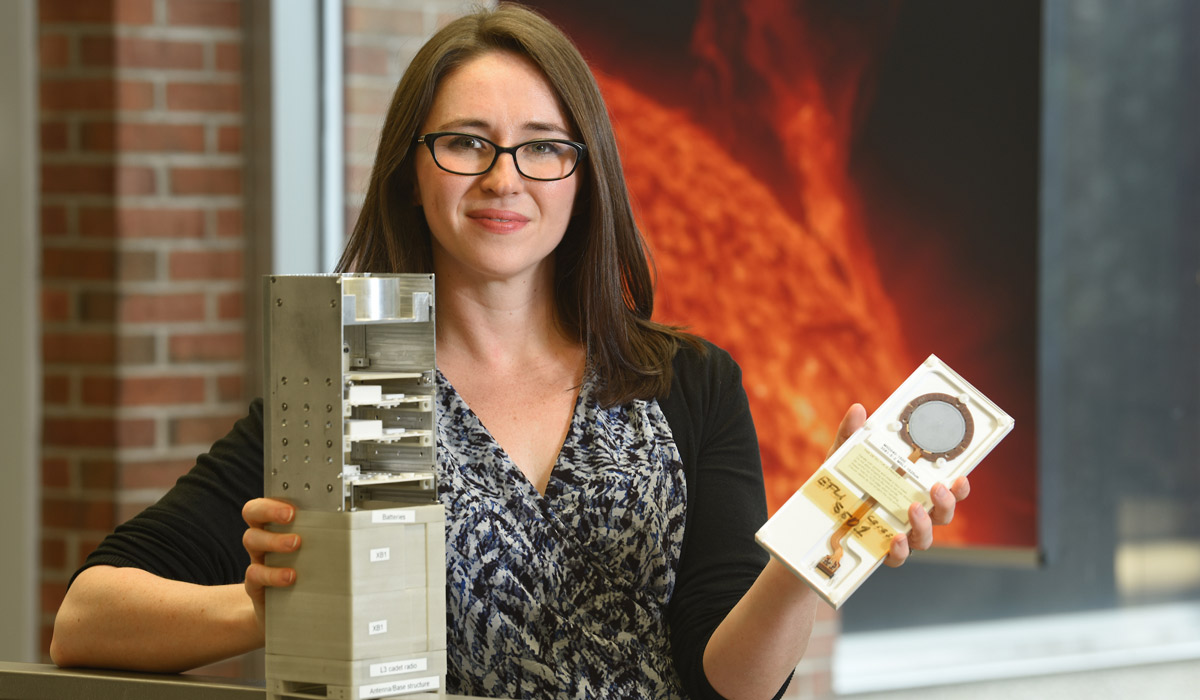

Ashley Greeley is building a satellite. "I know," said Greeley. "I tell people that and they always say, 'that sounds cool!' — but seriously, it is really cool."
In July, the tiny Cube Satellite, or “CubeSat,” developed by Greeley and her research team is scheduled to launch from New Zealand. The cube measuring 10cm x 10cm x 30cm will be sent into orbit inside the earth’s radiation belt about 500 km above sea level. The satellite will use special detectors that Greeley herself calibrated to measure the amount of protons and electrons in the earth’s radiation belt. Greeley’s team will use the CubeSat to determine whether there is a relationship between those particles and the electromagnetic waves measured by other satellites.
“Catholic has a very close relationship with the solar physics lab at Goddard, so everything just sort of fell into place.”
“Space weather is kind of a buzzword right now, but I guess you could summarize my research by saying that I study space weather’s effects on Earth’s magnetic fields,” said Greeley.
Pure science aside, the data from Greeley’s satellite may also shed light on a broad range of practical problems, like why highly energized particles disrupt GPS or sometimes interfere with the health of astronauts on missions.
Greeley’s work is sponsored by NASA. Her lab is located at the Goddard Space Flight Center, about 25 minutes from Catholic University. Historically, the University has had a good working relationship with Goddard, sending both graduate and undergraduate students to work in Goddard’s labs through paid internships and fellowships. Greeley found her position through an internship she discovered after college. She fell in love with the lab and after working there for about a year, her mentor, Shrikanth Kanekal, an adjunct at Catholic University, asked her if she would like to stay on as a graduate student.
“At the time I was thinking I wanted to do the physics without the grad degree, but my mentor just looked at me and said, “You can’t do the physics without a grad degree,” laughed Greeley. “So I said, well, I love what I’m doing right now, and he said that if I went to a local school I could keep working in the lab and do classes at the same time. It turns out that Catholic has a very close relationship with the solar physics lab at Goddard, so everything just sort of fell into place.”
Greeley says she feels very lucky to have worked on CeREs (A Compact Radiation bElt Explorer), the name of her CubeSat. Most satellites take decades and hundreds of millions of dollars to design, construct, and launch into space. CubeSats, however, cost “pennies” in comparison and the entire process from proposal to launch is about five years.
“I have gotten to sit in on everything from budget meetings to design to everything. It’s really cool,” said Greeley.
Greeley is slated to graduate with her doctorate next spring. She hopes to use the data she collects from her CubeSat in her dissertation. Once she graduates, she’ll likely move on from Goddard to expand her professional experience.
“I’m still trying to figure out what’s next,” said Greeley. “I love what I’m doing and I love D.C. It’s hard for me to think about leaving. I have a lot of good memories here. But you never know what the next step is.”
